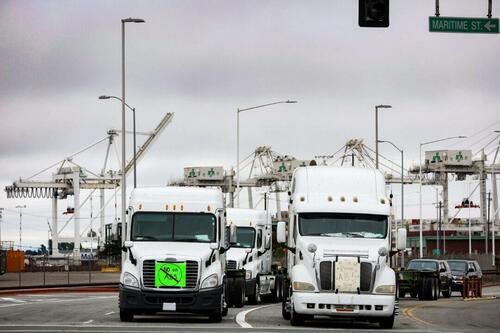
Transitioning Fleet Trucks To Electric Raises Costs By Up To 114 Percent, Report Warns
Authored by Naveen Athrappully via The Epoch Times (emphasis ours),

Transitioning conventional truck fleets to electric vehicles (EVs) pushes up annual operational costs, which subsequently increases economic inflation, according to a recent report from transportation and logistics firm Ryder.
Florida-based Ryder analyzed the potential cost of transportation if internal combustion engine trucks are converted to EVs. There is a 5 percent cost increase for light-duty EVs and a 94–114 percent increase for heavy-duty trucks, the May 8 report states. For a fleet of 25 mixed vehicles—light-, medium-, and heavy-duty trucks—costs surge by 56–67 percent.
As transportation costs have a direct bearing on the price of goods sold in markets across the country, Ryder estimates such increases to eventually add about 0.5–1 percent to overall price inflation in the economy.
“There are specific applications where EV adoption makes sense today, but the use cases are still limited. Yet we’re facing regulations aimed at accelerating broader EV adoption when the technology and infrastructure are still developing,” said Karen Jones, executive vice president and head of new product development for Ryder.
“Until the gap in TCT [total cost to transport] for heavier duty vehicles is narrowed or closed, we cannot expect many companies to make the transition; and, if required to convert in today’s market, we face more supply chain disruptions, transportation cost increases, and additional inflationary pressure.”
In California, the annual TCT increase for a heavy-duty EV tractor was approximately $315,000, with the number rising to more than $330,000 in Georgia. In both cases, equipment costs were the biggest contributor to the increase, rising by 500 percent.
Ryder noted there were 16.4 million Class 3 to Class 8 commercial vehicles in operation in the United States, out of which only an estimated 18,000 EVs have been deployed.
“Therefore, if companies are required to convert to EVs in the near future, availability and production of EVs may be far less than the vehicles needed to run America’s supply chains,” the report states.
The report points to a statement made by Clean Freight Coalition (CFC) that there is currently no network in the United States where truck drivers can take rest breaks and charge their EV batteries at the same time.
CFC estimates that electrifying the United States’ current commercial vehicle fleet would necessitate a $1 trillion investment.
Moreover, the International Council on Clean Transportation calculates that almost 700,000 chargers will be required to accommodate the 1 million Class 4, 6, and 8 electric trucks expected to be deployed by 2030. This alone will consume 140,000 megawatts of electricity per day, which is equivalent to the daily electricity needs of roughly 5 million U.S. homes.
“Ryder’s analysis underscores the reasons EV adoption for commercial vehicles remains in its infancy. In addition to the limited support infrastructure and EV availability, the business case for converting to EV for most payload and mileage applications, is extremely challenging,” the report reads.
Robert Sanchez, chairman and CEO of Ryder, said that although the company is actively deploying EVs and charging infrastructure, it has not seen any “significant adoption” of this technology.
“For many of our customers, the business case for converting to EV technology just isn’t there yet, given the limitations of the technology and lack of sufficient charging infrastructure,” he said.
Stuttering EV Adoption
The Ryder report comes as the Biden administration announced last month that it plans to spend nearly $1.5 billion to make the U.S. freight industry “zero-emissions.”
As part of the program, the Environmental Protection Agency (EPA) will offer $1 billion from the Inflation Reduction Act to cities and states “to replace Class 6 and Class 7 heavy-duty vehicles—which include school buses, trash trucks, and delivery trucks—with zero-emissions vehicles,” the White House said.
“Freight movement continues to represent a significant share of local air pollution, increasing the risk of asthma, heart disease, hospitalization, and other adverse health outcomes for the millions of Americans, especially overburdened communities, who live and work near highways, ports, railyards, warehouses, and other freight routes,” it stated.
The goal to transition to a zero-emissions freight sector “will prioritize actions to address air pollution hot spots and tackle the climate crisis, mobilizing a broad range of government resources, and reflect public participation and meaningful community engagement, furthering the President’s commitment to environmental justice for all.”
A recent report from consulting firm Roland Berger noted that full electrification of the U.S. commercial truck fleet would be an expensive affair. The cost of new electric trucks is twice or three times that of their diesel equivalents. A diesel Class 8 truck costs about $180,000, and a battery-electric truck costs more than $400,000.
Earlier, the EPA finalized the “strongest ever” greenhouse gas standards for heavy-duty vehicles, a move that attracted strong criticism from trucking organizations.
The Owner-Operator Independent Drivers Association called the standards an “assault on small-business truck drivers,” who make up 96 percent of commercial motor carriers.
On April 30, Nick Nigro, the founder of Atlas Public Policy, testified at a House hearing on fleet electrification efforts, supporting such initiatives. He insisted that such a transition is crucial to protect people’s health.
“We aren’t just racing against foreign nations to lead the development of 21st-century vehicle technology,“ he said. ”We’re also in a race to mitigate the worst effects of climate change on the planet and tailpipe pollution on human health.”
The American Lung Association estimates that transitioning to zero-emission trucks could result in $735 billion in public health benefits by 2050, he noted.
In his testimony at the hearing, Taki Darakos, the vice president of vehicle maintenance and fleet service at PITT OHIO, raised concerns about the high costs involved in electrifying fleets.
The upfront costs of zero-emission vehicles (ZEV) “are much higher than their diesel equivalent, making it difficult for fleets to embrace electrification until they see meaningful year-over-year upfront purchase price declines.”
The company incorporated some EVs in its fleet, and Mr. Darakos said: “Increased vehicle weight from the batteries reduced our payload and limited our usage of haul. These limitations have impacted the company’s timeline on how and when to transition to ZEV.”
The American Transportation Research Institute estimated that electrifying the entire vehicle fleet in the United States will consume 40 percent of the United States’ existing electricity generation while requiring a 14 percent overall increase in energy generation.
“Yet our aging grid can hardly meet current demands,“ Mr. Darakos said. ”In California, where rolling blackouts and brownouts are not uncommon, utilities would need to generate an additional 57 percent beyond their current output to support an electric vehicle fleet.”
He pointed out that a truck driver can refuel a new diesel truck within 15 minutes for a journey of up to 1,200 miles. However, charging an EV truck for two hours provides a range of only about 200 miles.
Tyler Durden
Tue, 05/14/2024 – 05:45
















